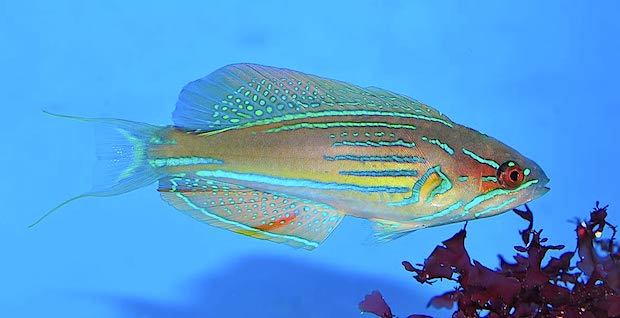As the countdown for 2014 ticks closer with each passing day, the chances of seeing another industry’s first grows narrower and narrower. We’ve seen some incredible fish this year, even some never before seen species, and here’s another last minute plus one addition to the small exclusive club. Paracheilinus hemitaeniatus is a quasi-legend we never thought we’d ever get to see but here it is, in the flesh, in the aquarium and in video.

P. hemitaeniatus is perhaps the rarest species in its genus, and is only known from three specimens captured from Madagascar. The holotype male, and two paratype females were captured off Tulear, at depths of around 140 ft. The isolated range and preference for rather deep rubble slopes has made this the most elusive and highly sought after species anywhere. Much like C. claire of the Cirrhilabrus genus, very little information and pictures are available for this species. Perhaps the most famous images are those taken by Dennis King, featuring the species in the wild.

As of what we know, there are a total of three specimens floating around the world now. The single male headlining this post by MCM (Meerwasser Center Menzel), and the second pair currently still at the Madagascar facility. This as far as we know, are the first ever specimens to be offered to the aquarium trade. As seen in the pictures of both wild and captured specimens, the males possesses a deeply lunate tail with extreme prolongation of the top and bottom caudal filaments.

As its name suggests, P. hemitaeniatus possesses a series of stripes that run only partially down the posterior portion of its body. The inky navy stripes are seen in both males and females, but as with all species of flasher wrasses, it is the males that are more colorful and beautifully decorated with extra finnage and patterns. The bottom most stripe of the males ends with a loop around the pectoral fin base and forms a shape very reminiscent of a Shepard’s crook. We couldn’t help but notice a trait that is seen in one other species of Paracheilinus, and like this one, it is also a resident of deeper waters. The fish is Paracheilinus piscilineatus.
The video above shows the second pair of P. hemitaeniatus filmed at the Madagascar holding facility. A truly sensational fish with the most terminal representation of a male for this species. Living pictures are already a treat, but nothing could have prepared us for a video. That crazy swallow tail took our breath away. Congratulations to Marine Aquaculture Nosy Be and Meerwasser Center Menzel for bringing some new light on the shiny new Madagascar flashers.



